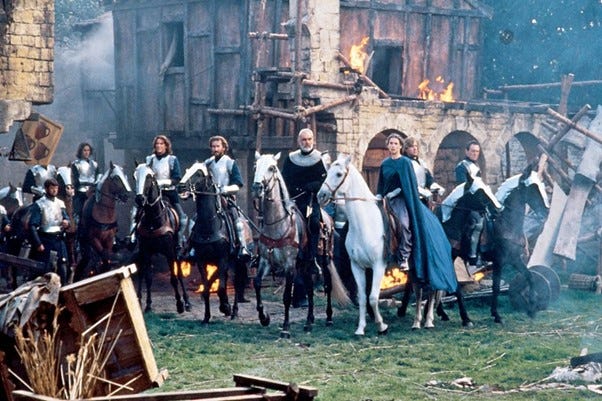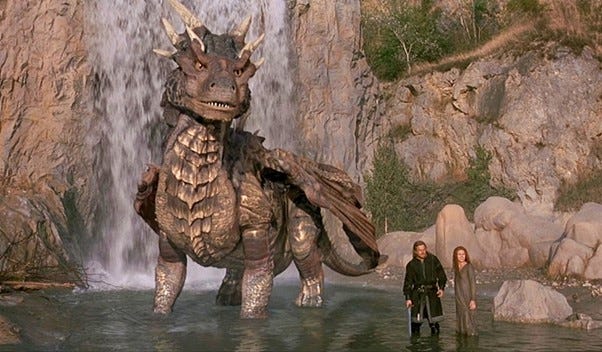Cinema of Swords
A Popular Guide to Movies about Knights, Pirates, Samurai, and Vikings (And Barbarians, Musketeers, Gladiators, and Outlaw Heroes)
By Lawrence Ellsworth
Welcome to the Cinema of Swords Substack! This series is a companion and expansion to the Cinema of Swords hardcover (Applause Books, 2023), which collects over 400 tasty mini-reviews of screen swashbucklers from the Silent Era through The Princess Bride.
This Substack builds on that foundation, continuing forward with reviews of swordplay movies and TV shows from the ‘90s to the present. Every week I’ll present two to four illustrated reviews on a common theme written both to inform and to entertain.
If you enjoyed the contents of the book, this weekly series will give you plenty more of the same. (And if you haven’t seen the book, look for it wherever you do your book shopping!)
Knights and Dragons
Hollywood loves making films about knights in shining armor, despite the fact that whenever they take a swing at the genre it’s as likely to be a miss as a hit. Often the result is a thoroughly mixed bag, a movie worth watching only once, and that’s what we have for your consideration this week with this pair of fables of heroic knighthood from the mid-‘90s. Each has its moments, particularly DragonHeart, but make no mistake about it, these aren’t art films, they’re committee-made products created in hopes of striking a chord with a global audience and thereby raking in the big bucks. Maybe next time: keep swinging, Hollywood!
First Knight
Rating: ***
Origin: USA/UK, 1995
Director: Jerry Zucker
Source: Columbia Blu-ray
This is an adaptation of the Arthurian legends, a retelling of the doomed love triangle of King Arthur, Queen Guinevere, and Sir Lancelot. This version takes the unusual approach of eliminating all elements of the fantastic from the tale, which is fine, but when you remove that, you have to focus on something else to make up for it, the leading choices being period realism, serious character drama, or sheer action.
Realism is out: early in the film, one of the first things we see upon arriving in Camelot is a colossal “gauntlet” contraption of whirling flails, stabbing swords, and swinging axe blades that warriors are challenged to pass through safely. It’s ridiculous. That outrageous device, amid the trappings of a fairy-tale kingdom rather than an authentic medieval realm, indicate that historical accuracy is not on offer here.
However, an attempt is made at serious character drama, which is also fine because with Arthur, Guin, and Lancelot we’re deep in romantic tragedy territory. However, director Jerry Zucker, previously known for slapstick comedies such as Airplane! and Naked Gun, just flubs it: his only idea for shooting intimate conversations is to frame staid close-ups in which the actors speak their lines as if reading them from the script. No edges, angles, mood lighting, or camera movement: it’s all flat and lifeless. So much for drama.
That leaves action, and here the movie acquits itself reasonably well, with a half-dozen chase and combat scenes that are reasonably tight. The one major open field battle is set at night, a mistake when both sides’ uniforms are different hues of black so you can’t tell what the hell is going on. Fortunately, the film makes up for that blunder with a wild melee at the end that’s quite effective, mainly due to the top-notch swordplay choreographed by Bob Anderson. Kudos for that.
A bit of plot for context: Arthur (Sean Connery) has won most of his battles and wishes to retire to Camelot with his much-younger queen, Guinevere (Julia Ormond), but the peace of the realm is threatened by Prince Malagant (Ben Cross), a former Knight of the Round Table gone bad who is after Guinevere’s domain of Lyonesse. Lancelot (Richard Gere) is in this version not a French noble knight come to join the Round Table because he shares Arthur’s vision, but instead a wandering sellsword of common birth and a certain roguish charm. He happens along in time to rescue Guinevere from the first of Malagant’s many abduction attempts, and sparks fly even though she’s committed to marrying Arthur. Ormond does well with her role, even if it does mean getting kidnapped an awful lot, but Gere and Connery aren’t given much to work with: Arthur is a preachy old duffer who speaks in moral aphorisms, and Lancelot is worse, simple, shallow, and dull. Gere’s idea of acting is to gaze into the camera and crinkle his eyes to convey sexy hawtness or vague concern (it isn’t easy to tell them apart).
All in all, First Knight is rather lightweight for an Arthurian tale and its tragic romance doesn’t really land—which is too bad, but there’s always John Boorman’s Excalibur. A word about the costumes: the Knights of the Round Table here are outfitted in severe blue and black armor that looks like it was designed by Hugo Boss for a procession in the 1936 Berlin Olympics, and it’s bloody unforgiveable. Maybe it’s just me, but I think it’s a major tonal mistake to dress the noble knights of Camelot as authoritarian goons; I kept expecting them to slap their chests and shout, “Hail, Arthur!”
DragonHeart
Rating: ***
Origin: UK/USA/Slovakia, 1996
Director: Rob Cohen
Source: Universal DVD
Though Dennis Quaid as Sir Bowen is the nominal lead in this medieval fantasy film, the real star is the animated dragon Draco, voiced by Sean Connery. As brought to life by Phil Tippett and Industrial Light & Magic, Draco is the first full-CGI character to carry a full theatrical film, and though the flexible features he’s given so he can express human emotions make him a trifle cartoonish, he fits well enough into the live-action environment to be effectively a member of the cast. This is an achievement that will lead to many good—and terrible—CGI characters to follow.
If only Draco’s story were less contrived and more convincing. In an unnamed European kingdom in the late 10th century, the peasants are oppressed by cruel King Freyne (Peter Hric), though his son, Prince Einon (David Thewlis), is being taught the virtues of the Arthurian “Old Code” by his loyal knight Sir Bowen (Quaid). When the king is killed putting down a peasant rebellion and his son is mortally wounded, Bowen and Queen Aislinn (Julie Christie) take Einon to a mystic cave where a dragon, cloaked in shadows, revives the prince by implanting half his draconic heart in the prince’s chest. The dragon makes Bowen and Einon vow to uphold the Old Code, and the prince swears, but he doesn’t mean it.
Once recovered and crowned, now-King Einon turns out to be a right bastard and a ruthless peasant-oppressor. Instead of recognizing that Einon had always been a weasel, Sir Bowen blames the hidden dragon for corrupting him, and spends the next ten years killing every dragon he can find. The last one turns out be Draco, the one who leant his heart to Einon, but he coyly pretends otherwise to Bowen, persuading the knight not to kill him but instead to join him in repeatedly pretending to kill him to defraud villages of the dragonslayer’s reward. (Credulity strained yet?) Along the way they pick up sidekicks: Brother Gilbert (Pete Postlethwaite), a hapless poet-historian monk riding the mandatory comical donkey, who proves to be not so hapless after all, and Kara (Dina Meyer), the furious daughter of a rebel leader killed by Einon, a firebrand who is determined to foment another rebellion, successful this time.
Though the characters are reasonably engaging, this story is just silly, and seems to have been somewhat dumbed-down by the producers in hopes of creating a family-friendly fable that would connect with a broad audience and establish a franchise. And DragonHeart has been successful, inspiring three sequels to date, though whether this is thanks to or in spite of its dumbed-down story is debatable. What isn’t debatable is that the combination of ILM’s animation and Connery’s warm performance really sell the Draco character, and that’s what most viewers take away from the film. Quaid’s Sir Bowen is more than adequate as the knightly hero, active and personable, and the fantasy combat, overseen by swordmaster Kiyoshi Yamasaki (Conan the Barbarian), is exaggerated but packs the requisite punch. So, enjoy the dragon, but no good can come from thinking too hard about the plot.
Next Week: Xena: Warrior Princess, a true high point for fantasy on television. Don’t miss it!
About Lawrence Ellsworth
Lawrence Ellsworth is the historical fiction nom de plume of Lawrence Schick, author of The Rose Knight’s Crucifixion and editor of The Big Book of Swashbuckling Adventure. See my website at swashbucklingadventure.net.
My current ongoing project is compiling and translating new, contemporary editions of all the books in Alexandre Dumas’s Musketeers Cycle, a series that when complete will fill nine volumes. Volume 7, Devil’s Dance, is currently being published in serial form on the Substack platform. Volumes 8 and 9 are forthcoming. Check out the series at musketeerscycle.substack.com.
As Lawrence Schick, I’m a writer and game designer primarily associated with narrative or role-playing games, a career I’ve pursued for over forty years, starting in the late 1970s working for Dungeons & Dragons co-creator Gary Gygax, moving into video games in the ‘80s and then online role-playing games in the ‘90s. I was lead writer and “loremaster” for The Elder Scrolls Online for over nine years, and most recently I’ve returned to D&D as the Principal Narrative Designer for Larian Studios’ smash hit Baldur’s Gate 3.
Copyright © 2023 Lawrence Schick. All rights reserved.









O boy, Xena's coming!
Pant, pant.
I recall seeing these two movies -- once each, maybe twice. Both were very disappointing. Poor Julia Ormond hardly ever lands in a decent script and why does everyone in this movie seem to wear blue? I recall how drab I thought the film looked. About the only other thing remembered is Connery's angry outburst, "The law will see to you!" in a heavy raspy brogue.
The only thing I want in a dragon movie is for the dragons to eat everybody, every pesky puny human in sight, and that almost never happens.